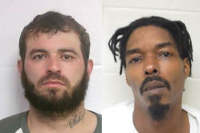Irving still churning out sublime writing
 Avenue of Mysteries is John Irving’s fourteenth novel and it marks another amazing tale from an author who has been writing for half a century. For those of us who read The World According to Garp (1978) and A Prayer for Owen Meany (1989) — two works that remain best sellers — the reader may rest assured that we are once more in a familiar John Irving landscape: a world replete with abandoned children, transvestites, a guilt-ridden protagonist, faithful dogs, shocking crimes and bizarre, disturbing rituals, not to mention a generous amount of explicit sex. This time out, Irving adds a new theme — occultism and the supernatural.
Avenue of Mysteries is John Irving’s fourteenth novel and it marks another amazing tale from an author who has been writing for half a century. For those of us who read The World According to Garp (1978) and A Prayer for Owen Meany (1989) — two works that remain best sellers — the reader may rest assured that we are once more in a familiar John Irving landscape: a world replete with abandoned children, transvestites, a guilt-ridden protagonist, faithful dogs, shocking crimes and bizarre, disturbing rituals, not to mention a generous amount of explicit sex. This time out, Irving adds a new theme — occultism and the supernatural.
In the opening chapter, Irving launches a plot with two time frames. His 54-year-old protagonist, a famous novelist, Juan Diago Guererro, has undertaken a journey to Manila in an attempt to fulfill a promise that he made 40 years earlier to an anonymous young draft dodger. However, the novelist is in failing health and has a rigid daily medication that requires him to alternate between doses of beta-blockers and viagra. Suffering from hypertension and erectile dysfunction, Juan Diago finds himself living in two worlds — the real world of his trip to Manila (2011) and the dream/memory world of his childhood (1970).
When Juan Diago “returns” to his childhood, he is back in a garbage dump outside Oaxaca, Mexico, where he and his sister, Lupe, are scavengers, sorting glass, copper and tin for the dump boss, Rivera. It is a nightmarish setting which Juan Diago compares to hell since the dump fires burn constantly.
It is also the home of hundreds of stray dogs which are often rabid and die in the dump and are thrown into the fires. It is here that Juan Diago learns to read the books that he snatches from the dump fires and, within a short time, acquires a reputation since he learns to read several languages. Lupe has the ability to read people’s minds, but since she is a semi-hysteric and has malformed vocal chords, no one can understand her except Juan Diago.
Their mother, Esperanza is a cleaning lady and part-time prostitute who is despised by her daughter, Lupe, who is also a relentless critic of the Catholic church and spends much of her time denouncing the numerous effigies of Mary, the mother of Christ. However, Lupe feels a affinity for the huge statue of Our Lady of Guadalupe which she feels is the true “Mother” of the Mexican people since she is dark-skinned.
A number of monks and inhabitants of the dump attempt to protect Juan Diago and his sister, but it is a hazardous environment. In time, Esperanza is killed by a huge effigy of Mary which falls on the cleaning woman while she is attempting to clean it. In Lupe’s mind, her mother was murdered by the effigy and she vows to take revenge. It well may be that she succeeds!
Related Items
However, both Juan Diago and Lupe are doomed as are the majority of ill-begotten characters that become friends or protectors of the children. Eventually, Juan Diago is run over by Rivera’s truck, rendering him a cripple for life. After Esperanza’s death, a transvestite named Flor and a Catholic acolyte named Edwardo (who loves to wear gaudy Hawaiian shirts) attempt to save the children by “adopting” them and moving to Iowa. The action is too late for Lupe, who dies one of the most bizarre deaths in this novel when the brother and sister take up residence in a local circus where they hope to live by Lupe’s ability to read people’s minds. Their plans miscarry and Juan Diago moves to Iowa with his new adoptive parents (both of which are HIV positive).
So, out of this wreckage, Juan Diago survives. After the deaths of his adoptive parents, he emerges as a gifted writer and spend several decades as one of the most notable Mexican-American writers. It is only now, in the latter part of his life that Juan Diago remembers his promise to a young American draft-dodger who told him about his father’s death in the Philippines and his hope that he would one day visit his father’s grave. So it is that Juan Diago tells the doomed your man that he will fulfill his wish for him and make the promised journey to the Philippines.
Now, about those two time frames. The one summarized above is Juan Diago’s childhood and his precarious early years. The Avenue of Mysteries begins with the 54-year-old protagonist boarding a plane to begin a long journey with frequent detours. Juan Diago is armed with a stock of medication that his trusted doctor has given him with some strict instructions about taking them in the prescribed manner. Early into the trip, the writer finds himself in the company of a mother and daughter who assure him that they are there to see he has an enjoyable trip. Who are they? Poor Juan Diago never get past first names: Miriam and Dorothy.
As the journey continues, the two attractive women go to considerable trouble to “entertain” Juan Diago. All of the travel plans have been made by one of the old teacher’s former students, Clark French, who is also a writer. Eventually, the plans become a tug of war between Clark and the two women. Eventually, Clark becomes alarmed and suggests that there is something “sinister” about the two women. He even goes so far as to compare them to “succubi,” which are evil spirits that bewitch men and render them helpless through marathon sexual encounters.
At first, Juan Diago thinks that Clark is simply jealous. But slowly, he begins to notice things ... like Dorothy and Miriam do not cast reflections in mirrors and when he awakes at night beside them, Juan Diago cannot detect a heart beat in either of the two women. Could it be? Are they there to bring on the heart attack that Juan Diago’s doctor has warned him about?
There is much in this novel that is bewildering, but there is also something else. Here and there are are patches of fantastic writing. For example, Irving’s description of the crazed stampede up the steps of the temple (the Avenue of Mysteries) that houses the Lady of Guadalupe:
There were platoons of businessmen, blind-folded and tied together, all whipping themselves in a frenzy; hundreds of nuns, knee-walked up the steps with blood streaming down their legs; the air was full of screams and lamentations, farmers and peasants mutilating their faces with knives and all crawling upwards, all screaming, ‘Mother, help me!’
Often, Lupe, Juan Diago’s hysterical sister delivers a kind of symphony of obscenity and curses that constitutes an attack on the Catholic church and its doctrines. Indeed, the heart of this novel seems to be a blistering attack on Catholicism and the massive suffering that it has inflicted on the poverty-stricken people of Mexico.
Avenue of the Mysteries left me a bit stunned. Certainly, it is unforgettable. I may return to Irving’s early works which are also filled with suffering and tragedy, but somehow, the past novels seem more redemptive ... and not a one of them has a “succubi.”









